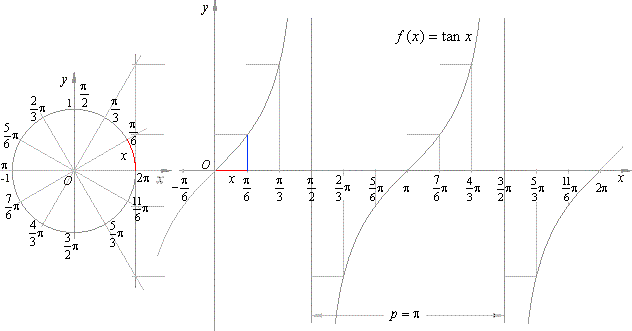|
| Trigonometry |
|
|
Graphs of
Trigonometric Functions |
|
The Graph of the
Tangent Function f
(x) = tan
x |
 Properties of the tangent function
Properties of the tangent function
|
|
Domain and range |
|
Zeros of the tangent
function |
|
Parity and periodicity
of the tangent function |
 The
tangent function behavior
and monotony
The
tangent function behavior
and monotony |
|
|
|
|
|
|
|
|
|
|
|
Graphs of
trigonometric functions |
|
The graph of the
tangent function f
(x) = tan
x |
| By associating the ordinates of the points that according to definition equals the tangent of an arc in the unit
circle, to corresponding arc x
in a coordinate system obtained are points P
(x, tan
x)
of the graph of the tangent function. |
 |
|
| Properties of the tangent function
|
| - Domain and
range |
|
From the definition of the tangent, tan
x = sin
x/cos
x, follows that all real numbers belong to the domain of the tangent function except the zeroes of the cosine function, thus |
|
Df = R \
{(2k + 1) · p/2,
k Î
Z}.
|
| As shows the graph in
the above figure, tangent function takes all real values from
-
oo
to
+
oo
as its argument
x
passes through an interval of the length p, therefore the range |
|
f (D) = R
or -
oo < tan x < + oo. |
| - Zeros of the tangent
function |
|
The zeroes of the tangent are determined by the zeroes of the sine function
in the numerator, so |
| x =
kp,
k Î
Z.
|
| -
Parity
and periodicity |
| The
tangent is odd function since |
| f
(-x) =
tan (-x) =
-
tan x = -
f (x). |
|
It is obvious from the graph that the tangent is periodic function with the period
p = p.
Thus, for every arc x
from the domain |
| tan
(x + kp) =
tan x. |
|
| Behavior of the tangent function
(monotonicity - a function consistently increasing or decreasing in value) |
| The tangent is increasing function in every interval between any of the two successive vertical
asymptotes |
| that
is, f (x1)
< f (x2)
for all x1 <
x2.
|
| The equations of the vertical asymptotes are,
x = p/2
+ kp.
|
|
|
|
|
|
|
|
|
|
|
|
|
|
|
|
|
|
| Trigonometry
contents A |
|
|
 |
|
| Copyright
© 2004 - 2020, Nabla Ltd. All rights reserved. |